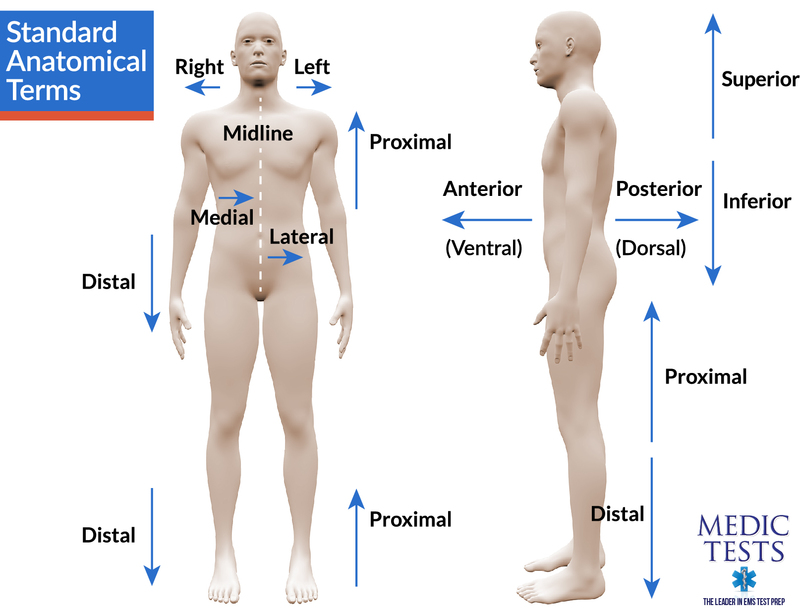Test Complete
- Questions
- Score
- Minutes
| Overall Results | |
|---|---|
| Total Questions |
| Category Results | |
|---|---|
STANDARD ANATOMICAL TERMS AND PLANES
Category: Medical
Topic: Basic Anatomy and Physiology
Level: EMR
Next Unit: The Circulatory System
5 minute read
Standard Anatomical Terms and Planes
 A standard system for describing the location and position of a given body part was created to ensure accurate and specific communication across all areas of healthcare. These terms are "patient-oriented," meaning the term "right side" refers to the patient's right side and vice versa.
A standard system for describing the location and position of a given body part was created to ensure accurate and specific communication across all areas of healthcare. These terms are "patient-oriented," meaning the term "right side" refers to the patient's right side and vice versa.
The image to the right provides an excellent visual guide to these terms.
Anterior or "Ventral" refers to the front of the patient. Posterior or "Dorsal" refers to the back of the patient.
Example: The dorsal fin of a dolphin is on its back.
Midline refers to the imaginary line that divides the body into symmetrical left and right halves. "Medial" refers to a location that is closer to the midline. "Lateral" refers to a location that is further from the midline.
Example: The nipple is medial to the armpit.
Superior "Cephalad" refers to a location closer to the patient's head. In comparison, Inferior "Caudal" refers to a location closer to the patient's feet.
Example: The neck is inferior to the head.
Deep and Superficial refer to the depth of an object or structure within the body. It is usually used to classify penetrating objects and lacerations.
Example: The muscle is deep to the skin."
Distal and Proximal are terms that describe the location of a structure in relation to another structure on a limb. A distal structure is further away from the attachment point of the limb.
Example: The ankle is distal to the knee.
Supine and Prone are terms that describe how a patient is lying down. Supine patients are lying on their posterior plane, whereas Prone patients are laying on their anterior plane.
Planes of the Body
 Anatomical planes are imaginary lines used to divide the human body. These are used to describe the location of structures or the direction of movements. They are less commonly used in EMS practice than the anatomical terms but still regularly appear on registry exams.
Anatomical planes are imaginary lines used to divide the human body. These are used to describe the location of structures or the direction of movements. They are less commonly used in EMS practice than the anatomical terms but still regularly appear on registry exams.
Frontal or Coronal Plane is a vertical plane that divides the body into the front (ventral) and rear (dorsal) halves.
Saggital or Lateral Plane is a vertical plane that divides the body into left and right halves.
The transverse or Axial Plane is a horizontal plane that divides the body into upper (superior) and lower (inferior) sections. It is perpendicular to the frontal and sagittal planes.